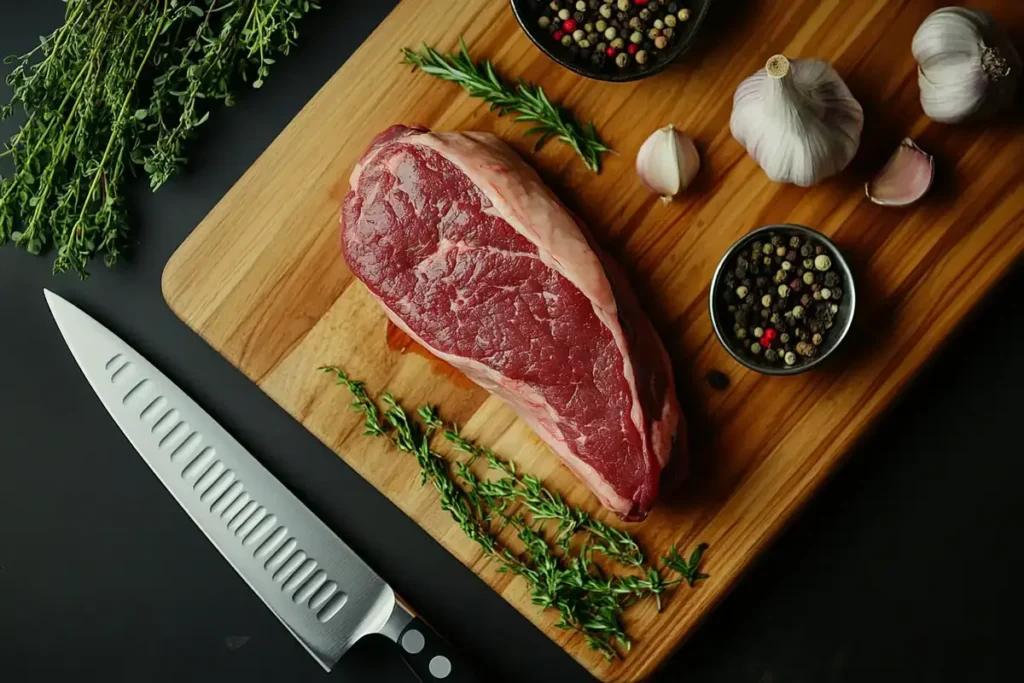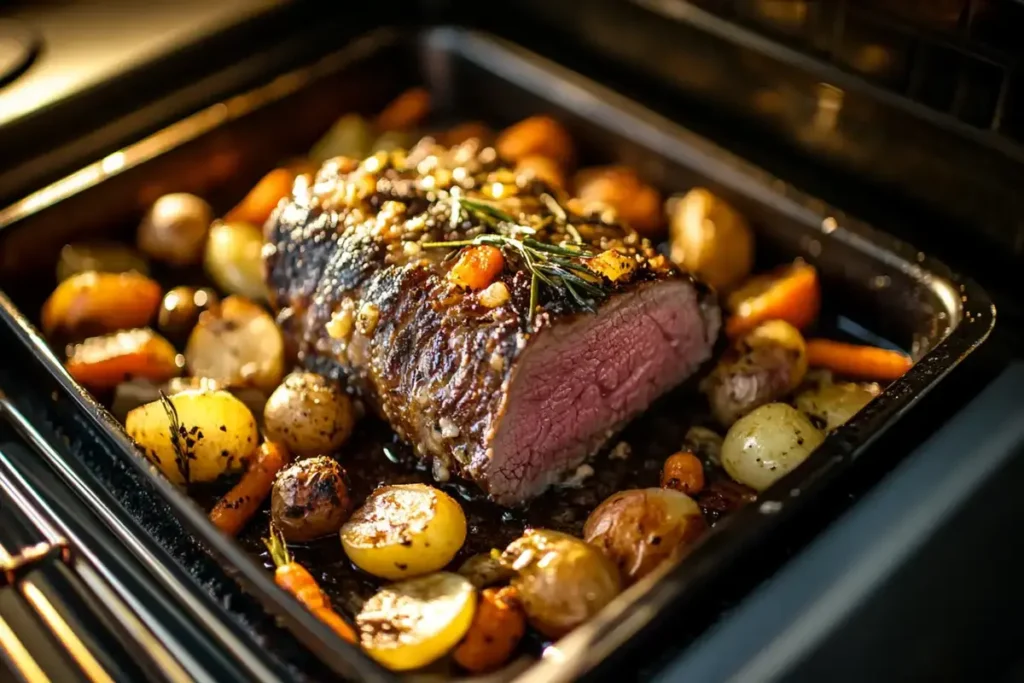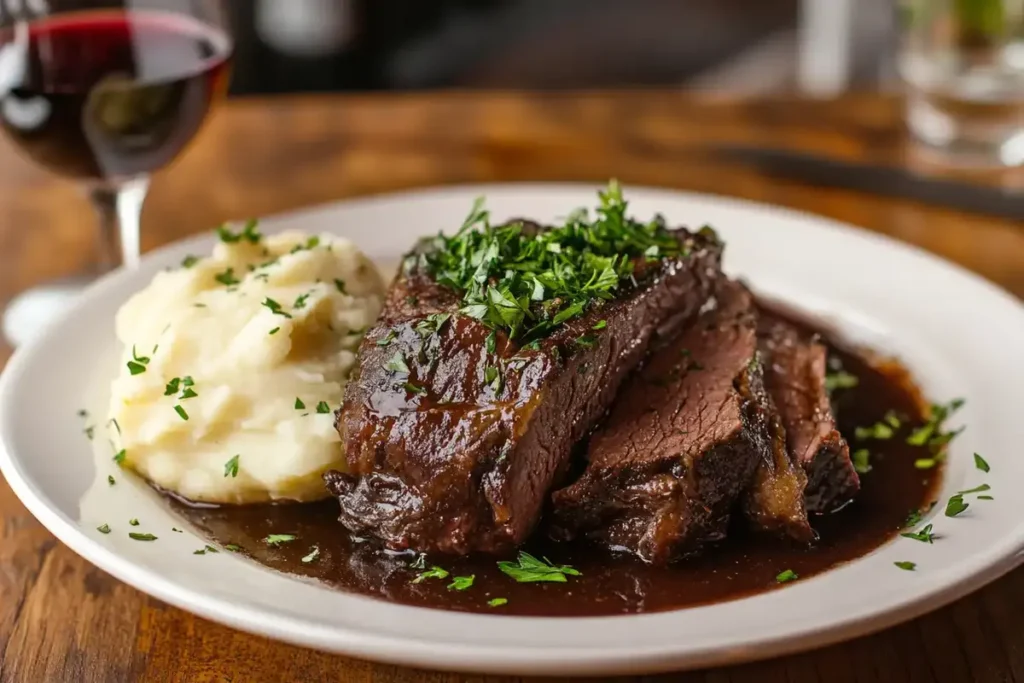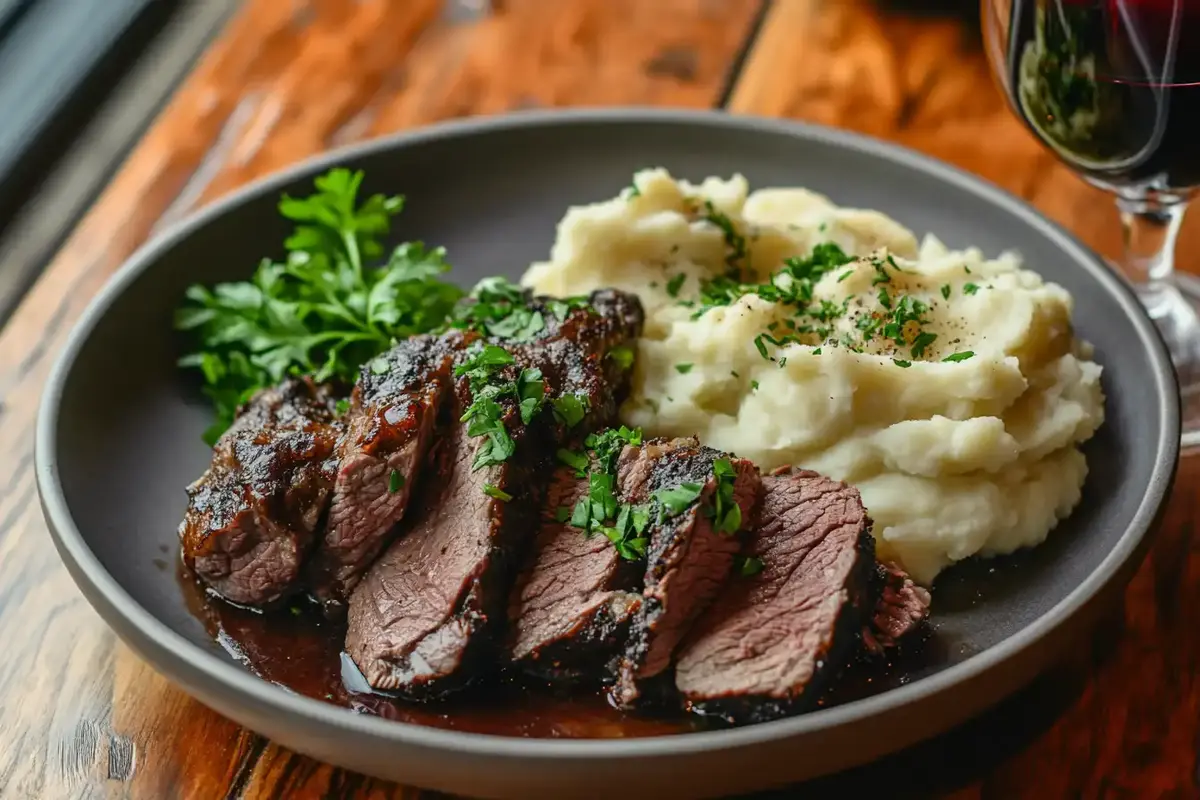Beef arm roast, a versatile and flavorful cut of meat, has earned a cherished spot in kitchens worldwide. Known for its tender texture when cooked correctly and its hearty taste, this cut is perfect for family meals, holiday gatherings, or even weeknight dinners. This guide will walk you through everything you need to know about beef arm roast: from selecting the best cut to mastering cooking techniques, serving ideas, and even answering your most pressing questions.
Introduction
What is Beef Arm Roast?
The beef arm roast, also known as the arm pot roast or chuck primal, is a cut derived from the shoulder area of a cow. This cut boasts an excellent balance of lean meat and marbling, making it a favorite for slow cooking methods like braising or roasting. The connective tissues, when broken down during cooking, lend a juicy tenderness to the dish, creating a hearty and delicious meal.
The arm roast has a cylindrical shape and may include a round bone, adding to its rustic appeal. It’s often more affordable than other premium cuts, yet it delivers incredible flavor when prepared correctly.
Nutritional Profile
If you’re curious about nutrition, the beef arm roast doesn’t disappoint. It’s a rich source of protein, providing essential amino acids for muscle repair and growth. Additionally, it contains vital nutrients like iron, zinc, and vitamin B12, which support immune function and energy production.
Here’s a quick look at its approximate nutritional breakdown per 3-ounce serving:
| Nutrient | Amount |
|---|---|
| Calories | 180 |
| Protein | 23g |
| Total Fat | 9g |
| Iron | 2mg |
| Zinc | 5mg |
Notably, it’s an excellent choice for those who want a flavorful cut without sacrificing health benefits.
Selecting and Preparing
How to Choose the Perfect Beef Arm Roast
Selecting the right beef arm roast sets the stage for a delicious meal. With so many cuts on the market, it’s important to know what to look for. Start by choosing a roast with consistent marbling those thin streaks of fat running through the meat. This marbling ensures tenderness and flavor as the fat melts during cooking.
Additionally, opt for a cut that feels firm to the touch. Avoid pieces that have an excessively dark or grayish tint, as this may indicate poor quality or old meat. If possible, purchase your roast from a trusted butcher who can guide you on freshness and origin. Grass-fed options tend to have a slightly leaner profile but boast incredible flavor, so don’t overlook them!
Preparing Beef Arm Roast for Cooking
Proper preparation ensures your roast cooks evenly and delivers mouthwatering results.
- Thawing and Trimming: Always thaw your beef arm roast in the refrigerator, allowing it to defrost gradually. Avoid quick-thaw methods like microwaving, as these can alter the texture. Trim any excess fat around the edges but leave some for flavor during cooking.
- Seasoning Techniques: A good seasoning base is key to enhancing the roast’s natural flavors. Generously coat the meat with salt and pepper, and consider adding garlic powder, onion powder, or smoked paprika for depth. For an extra layer of flavor, marinate the roast for several hours or overnight using a mixture of olive oil, fresh herbs, and a splash of lemon juice. This step tenderizes the meat and infuses it with aromatic notes.

Cooking Methods
Oven Roasting Beef Arm Roast
Oven roasting is a classic method that highlights the rich, hearty flavors of a beef arm roast. Follow these steps for perfection:
- Preparation: Preheat your oven to 325°F (165°C). Place the seasoned roast on a rack in a roasting pan to allow air circulation, which promotes even cooking.
- Searing: Heat a skillet with a tablespoon of oil and sear the roast on all sides. This locks in the juices and creates a flavorful crust.
- Roasting: Transfer the roast to the oven and cook uncovered. The general rule of thumb is about 20-25 minutes per pound for medium-rare (internal temp: 135°F/57°C) or 30 minutes for medium (internal temp: 145°F/63°C).
- Resting: Once cooked, let the roast rest for 10-15 minutes before carving. Resting ensures the juices redistribute evenly.

Slow Cooker Beef Arm Roast Recipe
The slow cooker is your best friend for a no-fuss, tender roast.
Ingredients:
- 1 beef arm roast (3-4 lbs)
- 1 onion (sliced)
- 3 carrots (peeled and chopped)
- 3 celery stalks (chopped)
- 2 cups beef broth
- 2 cloves garlic (minced)
- Salt, pepper, and dried thyme (to taste)
Cooking Instructions:
- Preparation: Layer the vegetables at the bottom of the slow cooker. They act as a natural rack for the meat.
- Searing: Optional but recommended. Sear the roast in a skillet for added flavor.
- Slow Cooking: Place the roast on top of the veggies and pour the broth over it. Sprinkle seasonings and garlic evenly.
- Cooking Time: Cook on low for 8-10 hours or high for 5-6 hours. The result is a tender roast that practically falls apart!
Braising Beef Arm Roast
Braising is the secret to transforming the beef arm roast into a melt-in-your-mouth masterpiece.
What is Braising?
Braising involves slow-cooking meat in a small amount of liquid, which tenderizes the fibers and enhances the dish’s natural richness.
Detailed Method:
- Preparation: Preheat your oven to 325°F (165°C). Use a Dutch oven or heavy pot with a tight-fitting lid.
- Searing: Heat oil in the pot and brown the roast on all sides. Remove and set aside.
- Building the Base: Sauté onions, garlic, and carrots until softened. Add 2 cups of beef broth, a cup of tomato paste, and a splash of Worcestershire sauce. Bring to a gentle simmer.
- Cooking: Return the roast to the pot, cover, and transfer to the oven. Cook for 3-4 hours, turning the meat occasionally. The internal temperature should reach 190°F (88°C) for shreddable tenderness.
- Finishing Touches: Skim excess fat from the liquid, and serve the roast with the reduced sauce poured over it.
Enhancing Flavor and Tenderness
Marinades and Rubs
Popular Marinade Recipes
Marinating a beef arm roast adds a burst of flavor and tenderizes the meat before cooking. A classic marinade often includes olive oil, vinegar (or citrus juice), minced garlic, and fresh herbs like rosemary and thyme. For a more robust flavor, try adding soy sauce, Worcestershire sauce, or Dijon mustard. Combine these ingredients in a bowl, pour them over the roast, and let it soak in the refrigerator for 4-12 hours.
For a spicier twist, consider a chili-lime marinade. Mix lime juice, chili powder, cumin, paprika, and a touch of honey for a zesty, sweet-spicy kick.
Dry Rub Options
Dry rubs are perfect for locking in the natural juices while creating a flavorful crust. A simple dry rub might include salt, black pepper, smoked paprika, onion powder, and garlic powder. Want a bolder profile? Add cayenne pepper, brown sugar, and ground coffee for a smoky-sweet twist. Massage the rub thoroughly into the meat and let it sit at room temperature for 30 minutes before cooking.
Resting and Carving
Importance of Resting
Resting is a vital step to ensure your roast is juicy and tender. When the meat is hot, the juices are concentrated in the center. Allowing it to rest for 10-15 minutes after cooking redistributes those juices evenly throughout the roast. Cover it loosely with foil to keep it warm during the resting period.
Proper Carving Techniques
Carving a beef arm roast requires precision to maintain its tenderness. Use a sharp carving knife and slice against the grain—those visible lines in the meat. Cutting against the grain shortens the muscle fibers, making each bite more tender. Aim for slices about ¼-inch thick for a balanced texture and flavor. Serve immediately for the best experience!
Serving Suggestions and Pairings
Ideal Side Dishes
Traditional Accompaniments
When serving a hearty beef arm roast, classic sides like mashed potatoes, roasted carrots, and buttery green beans are a perfect match. These sides complement the rich, savory flavor of the meat without overpowering it.
Consider creamy polenta, crusty dinner rolls, or Yorkshire pudding to soak up the roast’s juices. These traditional options are comforting and crowd-pleasing.

Contemporary Pairings
If you’re feeling adventurous, pair your roast with roasted Brussels sprouts tossed in balsamic glaze or quinoa pilaf with cranberries and nuts. A refreshing arugula salad with lemon vinaigrette adds a light, modern twist that balances the roast’s richness.
Beverage Pairings for Beef Arm Roast
Non-Alcoholic Options
Not all meals call for wine, and thankfully, many non-alcoholic beverages pair beautifully with beef arm roast. A rich beef broth-based soup as a starter can set the tone, while a sparkling pomegranate or blackcurrant juice complements the meal’s hearty flavors. Additionally, herbal teas like rosemary or thyme-infused brews can provide a subtle, aromatic pairing.
Storing and Reheating Leftovers
Proper Storage Techniques
Storing leftover beef arm roast properly ensures it stays fresh and delicious for future meals. For refrigeration, transfer the roast to an airtight container or wrap it tightly in aluminum foil. Leftovers can be safely stored in the refrigerator for up to 4 days.
For longer storage, freezing is an excellent option. Slice the roast into individual portions, wrap each piece in plastic wrap, and place them in a freezer-safe bag. Properly stored, frozen beef arm roast remains good for up to 3 months. Always label your containers with the date to keep track of freshness.
Reheating Beef Arm Roast Without Losing Quality
Reheating can be tricky, as overcooking may dry out your leftovers. To maintain moisture, consider these methods:
- Oven Method: Preheat your oven to 250°F (120°C). Place the roast slices in a baking dish, add a splash of beef broth or gravy, and cover tightly with foil. Heat for 20-30 minutes or until warmed through.
- Stovetop Method: Use a skillet over low heat, add a little liquid (like broth), and reheat gently, flipping occasionally.
- Microwave Method: Place the roast in a microwave-safe dish with some liquid, cover it loosely, and heat in short intervals to avoid overcooking.
Frequently Asked Questions (FAQs)
What is the difference between beef arm roast and chuck roast?
While both cuts come from the shoulder area, beef arm roast is leaner and includes a round bone, making it slightly less fatty than the chuck roast. Chuck roast, on the other hand, has more marbling, which contributes to a richer flavor and makes it better suited for shredding.
Can I cook beef arm roast in an Instant Pot?
Absolutely! The Instant Pot is perfect for cooking a beef arm roast quickly while keeping it tender. Use the sauté function to sear the meat first, then add broth, vegetables, and seasonings. Cook on high pressure for about 60-75 minutes, followed by a natural release.
How do I know when my beef arm roast is done?
Use a meat thermometer to check the internal temperature. For a medium roast, aim for 145°F (63°C). For shreddable tenderness, slow-cook it until it reaches around 190°F (88°C). Always allow the roast to rest for 10-15 minutes before slicing.
Is beef arm roast suitable for grilling?
While beef arm roast isn’t typically a grilling cut due to its tough texture, it can be grilled if marinated thoroughly and cooked using indirect heat. Slow-cooking on the grill at low temperatures helps tenderize the meat.
What are some common mistakes to avoid when cooking beef arm roast?
- Skipping the sear: Searing adds flavor and seals in juices.
- Not resting the meat: Resting redistributes juices for a moist roast.
- Using high heat: Low and slow is the key to tenderizing this cut.
- Underseasoning: Generous seasoning is essential for depth of flavor.
How can I make my beef arm roast more flavorful?
Consider marinating the meat overnight to enhance its taste. Using bold rubs or basting it with beef broth during cooking also boosts flavor. Lastly, slow-cooking methods like braising allow the roast to absorb the rich flavors of the broth and seasonings.
Conclusion
The beef arm roast is a versatile, flavorful cut of meat that deserves a spot in your culinary repertoire. Whether you’re slow-cooking it in a crockpot, braising it to perfection, or roasting it in the oven, this cut offers a hearty, satisfying meal for any occasion. By selecting high-quality meat, using the right seasoning and marinades, and following proper cooking techniques, you can transform a simple beef arm roast into a dish that’s as tender as it is delicious.

